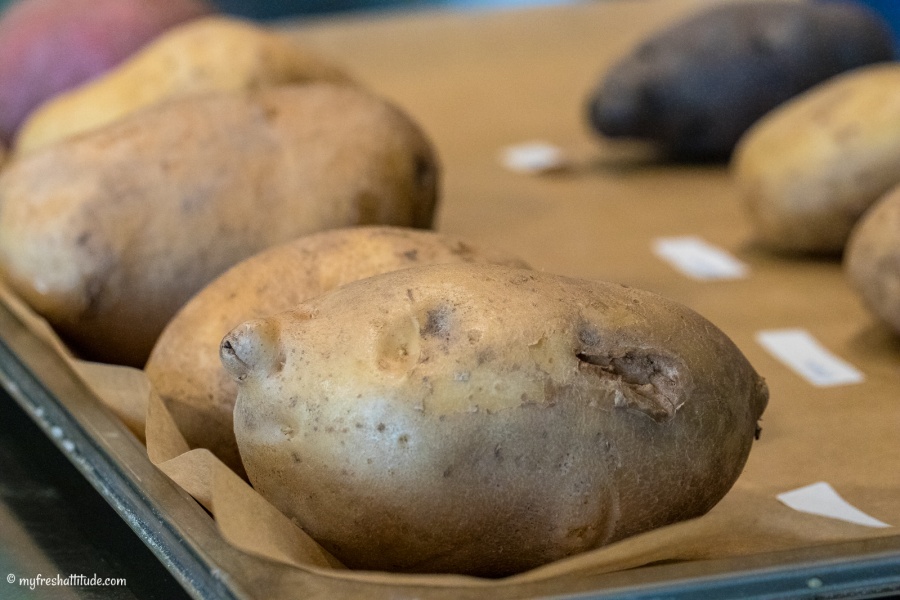
Potatoes
Let’s talk potatoes. I know this isn’t exactly everyone’s favorite topic – unless you are a fanatical food-loving nerd (guilty) – but potatoes are a major part of most everyone’s weekly food experience. Potatoes are one of those ingredients we take for granted; kind of in the same category as onions and garlic…or tomatoes. Potatoes are always on the supermarket shelf, so why would anyone consider seasonality? And then there’s this…recipes simply call for potatoes in a generic manner without ever considering what type of potato would work best. So, what’s the big deal? Why do I need to choose that brown potato instead of that cute red one? Can’t we just go on eating our chips and crisps (that would be fries and chips if you are an American English speaker) or that big blob of mash (potato puree for culinary purists) lathered in butter and cream without worrying too much about those potato details? And really, do we need to consider the healthy aspects of potatoes?
Well…this is precisely why I think we should talk about potatoes!
Perspective
Most of the world’s nourishment comes from what grows underground – and potatoes are the most popular subterranean food. And that fact alone means the humble potato is a food we need to spend more time getting to know.
Potatoes belong to a classification of food called tubers, which comes from the root: to swell. Indeed, potatoes are swollen underground nutritional storage units containing large quantities of starch and enough other nutrients to provide people with the necessary energy and nourishment to live. And I think that is rather important.
Potatoes are indigenous to Central and South America. At one time, there were over 600 varieties growing in that part of the world. Today, there are roughly 200 varieties which have survived and are grown throughout the entire world. After being introduced in Europe during the 16th Century, potatoes eventually became an important part of the diet. They thrived in cooler climates and were inexpensive to produce. But they were primarily classified as food fit only for the poor. Jews in European ghettos ate potatoes 3-4 times daily. Irish peasants ate an shocking 2-4 kg. (1-2 pounds) each day. During the early part of the 19th Century, potatoes became more popularized and eventually moved into mainstream diets of the middle class (thank you Dutch people of the world). It was during this period that the potato truly blossomed and a wide range of new recipes were created by inspired cooks.
Potatoes are now the most consumed vegetable in the world. But potatoes have also suffered from years of manipulation and turned into just another run-of-the-mill ingredient – an unfortunate consequence of being popularized on a global scale by McDonald’s. Sadly, most potatoes throughout the world are mass produced to exact specifications supplied to farmers by major food companies. Their poor flavor characteristics do not offer much to the curious cook who is looking for appealing ways to integrate the potato into their diet. As the famous English food author Elizabeth David once pointed out, “it is not potato recipes we lack, it is good potatoes.” Despite everything done to the potato, it still manages to play a prominent role in many European and American cuisines – Gnocchi in Italy, Knödel in Austria, Gratin Dauphinoise in France, Schupfnudeln in Germany, Rösti in Switzerland (also the American counterpart of hash browns), many potato pies throughout Eastern Europe and of course, French Fries (Chips) and Mashed Potatoes just about everywhere. It is precisely this demand for cultural preservation that gives the potato (and us of course) hope for the future. Today, with a little knowledge and desire, you can find excellent locally-produced potatoes – and even some varieties which just may have cheated extinction.
Specifics
It seems important to emphasize potatoes (like tomatoes, onions, garlic and other products that are always available) are a seasonal product. They are planted and need the correct growing environment in order to produce those tasty swollen tubers – and this takes time. Of course this seems so obvious, but most people don’t bother to think too much about where their food is coming from. However, if the seasonality of potatoes is taken into consideration before making any recipe, then cooks can capture their full and distinctive earthy flavors while benefiting from the maximum amount of nutritional gain.
Mature potatoes grown in natural environments are usually harvested from early summer and into the fall. But some varieties begin showing up much earlier in the year depending on growing conditions. For instance, if you’re in a temperate area (like the Mediterranean) potatoes will be harvested during the late spring and early summer. Conversely, if you’re in a colder weather climate – say Central Europe, then potatoes are planted later in the year and take longer to mature. And it is precisely this longer growing season that makes these potatoes different…but we’ll get into the different types of potatoes a bit later. For now, just accept that the most varietal options for potatoes are harvested when the summer wanes and cooler weather approaches. And these potatoes can actually benefit from a month or two of storage, making October to March the prime time to consume potatoes (also a time when colder temperatures mean humans should consume more carb-rich foods to help fuel our own internal energy demands to stay warm).
Purchasing Tips
So here’s what to look for when purchasing fresh potatoes. I start with the label if possible and try to determine the potato’s origin. Long transportation usually means a deterioration in quality. Next, take a good look at the potato – there shouldn’t be any significant patches of green on the potato’s surface or signs of sprouting from the eyes. Pick up the potato if you can and see if there are any soft spots. Healthy potatoes should feel firm and heavy for their size.
Under proper conditions most potatoes can be stored for months. They should be kept in a dark, cool location with relatively high humidity. Ideal temperature conditions are 7°C – 10°C (45°F – 50°F). If the temperature is too warm, potatoes will begin sprouting and decaying. If the temperature is too cold, potatoes will begin converting their starch to sugar, creating a strange flavor and consistency…so please avoid putting your potatoes in the refrigerator! Too much exposure to light will encourage the development of potentially dangerous levels of toxic alkaloids – and trigger chlorophyll to create those green patches. If your storage area is inadequate to properly hold potatoes, then consider making smaller purchases and plan to consume the potatoes within a day or two. New potatoes and most early-season varieties don’t store well. They should be consumed soon after purchase. Finally, be gentle with the potato. Despite their rugged look, potatoes actually bruise quite easily and develop deep internal dark spots which create a rather unpleasant bitter taste.
Selecting the Right Variety
Here’s where things get interesting – at least for self-confessed potato nerds! Selecting the correct potato type for a particular recipe will greatly improve the probability of a successful outcome…and most recipe books simply do not tell you this in advance. So, if the recipe you are looking at tells you to get a kilo (or 2 pounds) of ‘potatoes’, then your first question should be, ‘great, but what kind of potato?’ Should I get a potato that will fluff up into a light and airy mass or do I want my potato to hold its shape and not turn into a gluey mess?
Learning potato classifications will help you make this determination. Potatoes classified as mealy/starchy have high concentrations of starch in their cell walls, making them more dense than waxy potatoes. When heat is applied to the potato, the cells in mealy/starchy potatoes swell and separate, creating a fluffy and dry texture. This is perfect when you want to make a fluffy mash or baked potato…or even making creamy soups. Waxy potatoes, on the other hand, have less bursting starch and stubborn cell walls that do not easily separate when cooked. And this means this type of potato will hold their shape, retain moisture and remain firm when cooked – making waxy varieties ideal for steaming, sautéing, making gratins or using in salads.
It’s difficult to provide a comprehensive list of all potato varieties grown everywhere and listing their classification, so I will just put it this way – get to know your potato classification! If you’re not sure, then simply ask the recipe author (blog or book), ask the store manager or ask your favorite search engine. If you’re still in doubt, then get a large container and add enough water to completely cover a potato by a good amount. Add 10 grams (one tablespoon) of salt for every liter (quart) of water and mix well to dissolve the salt. Add the potato to the water – if it floats then it is the less dense waxy variety, and if it sinks you can be sure you have a denser starch/mealy variety.
Nutritional Considerations
Potatoes are a nutritional warehouse. They are excellent sources of energy and vitamin C and contain relatively few calories (it’s all that other stuff we tend to pile on potatoes that elevate the calorie count and give potatoes a bad name). On average, potatoes contain 0.2 grams of fat, 0.8 grams of fiber, 1 gram of minerals and vitamins, 2 grams of protein, 19 grams of carbohydrates and 77 grams of water. Incredibly, one middle-sized potato has one-third of the recommended daily allowance of vitamin C. Simply steaming potatoes with their skin on retains the most amount of nutrition – and this is a delicious way to enjoy potatoes by the way.
Potatoes also have a dark side. All potatoes contain small quantities of the toxic alkaloids solanine and chaconine. The presence of these alkaloids creates the slight bitterness which defines the potato’s flavor characteristic. Higher levels of alkaloids create an excessively bitter experience, a burning sensation in the throat, digestive and neurological problems, and in extreme cases – death (but let me emphasize extreme cases). Alkaloids develop during prolonged exposure to light. Fortunately, light also triggers chlorophyll formation and causes green spots to appear on the potato’s surface, meaning large patches of green indicate the presence of unsafe amounts of alkaloids, and these potatoes should be either deeply peeled or thrown away.
Jack’s Fresh Tip

What are new potatoes?
True new potatoes are immature tubers, harvested from green vines during late spring and throughout the summer. They are moist and sweet and have relatively little starch. New potatoes are quite perishable, and don’t store well.
Recipes with Potatoes

Tempeh Hash
3 0
Baked Potato Fries and Tangy Ketchup
10 4
Pommes Dauphinois
10 0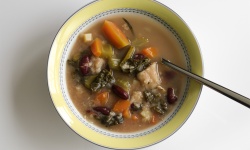
Ribolita
3 4
Potato Gnocchi
5 5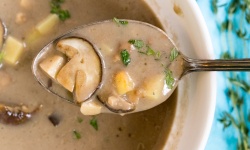
Roasted Garlic and Mushroom Chowder
6 0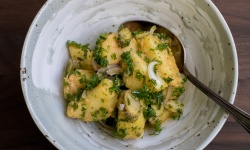
Italian-style Potato Salad
4 2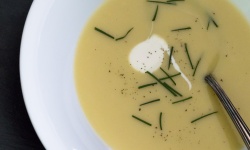
Vichyssoise
0 0
Pumpkin Rösti
1 0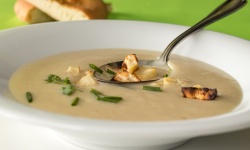
Roasted Celeriac and Potato Veloute
2 0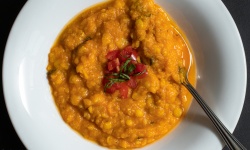
Tamatar Dal
4 0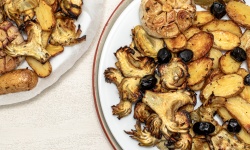
Provencal Artichokes and Potatoes
0 0
Swiss-Style Shepherd’s Pie
1 0
Spanish Tortilla…A Vegan Version
2 0
Spring Pea and Wild Garlic Chowder
0 0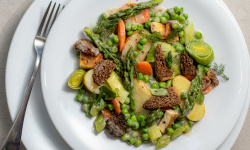
Spring Vegetable Fricassée
1 2
Älplermagronen
1 0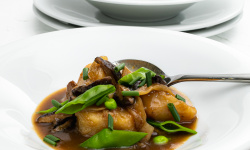
Japanese-style Potatoes and Mushrooms
1 0
Hungarian-Style Potato and Sauerkraut Goulash
0 0
Swiss-German Potato Salad
1 0
Curried Parsnip and Apple Chowder
2 0
Potato Rösti
1 0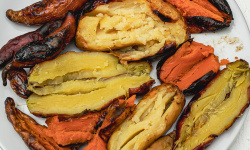
Slow-Roasted Sweet Potatoes
1 0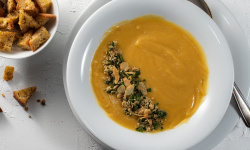
Sweet Potato and Jerusalem Artichoke Soup
1 1
Sweet Potato Gnocchi with Sage Oil
1 0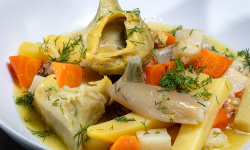
Mediterranean-Style Braised Artichokes
0 0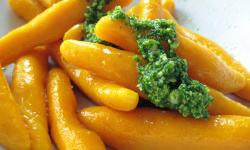
Pumpkin Schupfnudeln
0 0
There are no comments